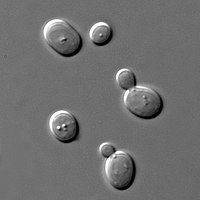
Photo from wikipedia
Abstract The outer cell wall of yeast is characterized by high levels of β-glucans and mannan-oligosaccharides (MOS), which have been linked with beneficial effects on intestinal health and immune status… Click to show full abstract
Abstract The outer cell wall of yeast is characterized by high levels of β-glucans and mannan-oligosaccharides (MOS), which have been linked with beneficial effects on intestinal health and immune status in dogs. In this study, a standardized in vitro simulation of the canine gastrointestinal tract (Simulator of the Canine Intestinal Microbial Ecosystem; SCIME) was used to evaluate the effect of a Saccharomyces cerevisiae-based product, consisting of 27.5% β-glucans and 22.5% MOS, on the activity (as assessed by measurement of fermentative metabolites) and composition (as assessed by 16S-targeted Illumina sequencing) of canine intestinal microbiota. The S. cerevisiae-based product was tested at three different dosages, i.e., 0.5, 1.0, and 2.0 g/d. A dose-dependent fermentation pattern was observed along the entire length of the colon, as shown by the increased production of the health-related acetate, propionate, and butyrate for the three concentrations tested (0.5, 1.0, and 2.0 g/d). A consistent finding for all three tested concentrations was the increased propionate production (P < 0.05) in the simulated proximal and distal colon. These changes in terms of fermentative metabolites could be linked to specific microbial alterations at the family level, such as the specific stimulation of the propionate-producing families Porphyromonadaceae and Prevotellaceae upon in vitro exposure to the S. cerevisiae-based product. Other consistent changes in community composition upon repeated exposure included the decrease in the Enterobacteriaceae and the Fusobacteriaceae families, which both contain several potentially opportunistic pathogens. Altogether, the generated data support a possible health-promoting role of a product high in β-glucans and MOS when supplemented to the dogs’ diet.
Journal Title: Journal of Animal Science
Year Published: 2020
Link to full text (if available)
Share on Social Media: Sign Up to like & get
recommendations!